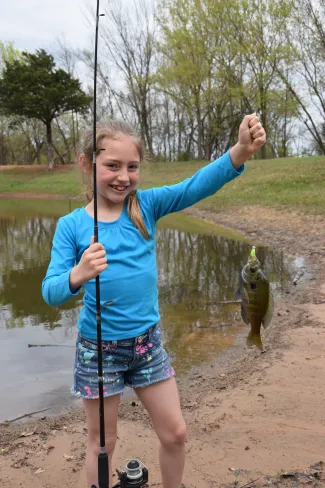If you are reading this section, you must be interested in big sunfish and have probably wondered if hybrid sunfish might help you reach this objective. Included here are the answers to many of the questions commonly asked about hybrid sunfish.
Sunfish hybrids share many of the same characteristics found in the more common fish hybrids such as the white bass-striped bass cross. These include faster growth rate, aggressive behavior, hybrid vigor and reduced reproduction. Unlike other species, sunfish hybridize naturally in steep-sided ponds. Because spawning sites may be limited in these ponds, and because sunfish are colonial nesters, eggs and sperm accidentally get mixed to produce hybrids.
As with the catfish and pike families, all possible crosses of sunfish have been created. However, it is easier to cross closely-related species. For example, bluegill hybridize with redear sunfish much easier than with largemouth bass.
One genetic quirk that occurs with sunfish hybrids is skewed sex ratios. For example, bluegill males crossed with green sunfish females will produce 90 percent male offspring, whereas the reverse cross will yield only 70 percent males. This skewed sex ratio is what makes the hybrid a good management tool because they do not overpopulate and stunt as readily as bluegill. However, hybrid sunfish will not produce enough offspring to provide adequate forage for largemouth bass growth.
The hybrid of most interest is the bluegill male-green sunfish female cross. One good characteristic of this cross is its ability to use artificial feed. By using artificial feed, the pond owner is able to raise more pounds of fish at a faster rate. This cross also provides excellent angling opportunities. They may be taken on a wide variety of tackle and their aggressive behavior is favored by children and anglers not talented at setting the hook. However, a significant disadvantage to this cross is that it produces little forage for good bass growth.
So, how do we go about managing these bluegill-green sunfish hybrids? There are two methods of getting started, both of which begin with a pond devoid of fish. The first method is easy. Obtain fingerlings from a commercial dealer and stock them at a rate of 100 per acre if you are not going to feed, or up to 500 per acre if you plan to feed. Stock them in late spring or summer. That fall, 100 channel catfish fingerlings may be added. Then, one hundred largemouth bass fingerlings should be added the following spring. Hybrids and channel catfish may be harvested when they reach a satisfactory size. Harvested fish must be replaced to maintain quality angling. Largemouth bass should not be harvested for three years; then impose a minimum bass length limit of 12 or 14 inches.

The second method of setting up a hybrid bluegill pond requires the pond owner to be more of a biologist. Sunfish broodstock must be collected prior to the spring spawning season. May and June are the best months to set up a hybrid bluegill pond. To distinguish males from females by gently squeezing the abdomen until either milt (a milky-looking substance) from the males or eggs from the females are obtained. There is no room for error! If a fish does not look like a pure bluegill, or its sex cannot be determined, do not use that fish!
After obtaining male bluegills and female green sunfish, stock at the rate of five bluegill males and five green sunfish females per acre. Since there are no opposite-sex sunfish of their own species in the pond, they will readily cross to produce the hybrids. This stocking will be good for a period of five years. Channel catfish may be added that fall, followed by largemouth bass in the spring. Brood sunfish need to be replaced every five years. Replace channel catfish as they are harvested. Again, a minimum length limit of 12 or 14 inches should be used on the largemouth bass with no harvest the first three years. Hybrid bluegill are well worth the trouble. Ponds with hybrids in the one-half to three-quarters of a pound range are very common, but fish weighing two pounds are rare. They work well with channel catfish in a feeding program. Follow the feeding schedule described under Channel Catfish Pond.
Hybrid bluegill will have a better food conversion ratio when fed on alternate days rather than every day and will feed more vigorously at cooler temperatures than channel catfish. Small hybrids need to be eaten by largemouth bass, and because of limited reproduction by hybrids, bass will remain small. Overall, the bluegill-green sunfish hybrid is a hard fighting sport fish.